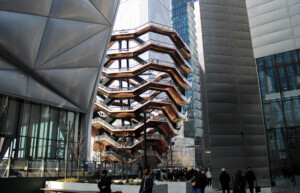New York State Assembly officials are gearing up to pass legislation that goes into effect July 21, 2024 with financial implications for architecture workers. The statute will allow employees at New York Design Professional Corporations (DPC) to “fully use the ESOP ownership form for the first time,” a press announcement from Albany stated.
ESOP stands for Employee Stock Ownership Plan. Today, over 10 million workers in the U.S. have ESOPs, or about 1 in 13 people in the job force. In the AEC industry, firms like Ayers Saint Gross, BNIM, SHoP Architects, HDR, HNTB, Gensler, Zaha Hadid Architects, and IA Architects offer ESOPs. The global landscape firm SWA was one of the first design companies to become “employee-owned” when it gave workers ESOPs in 1973.
What an ESOP does is give employees shares in the company they work for in exchange for compensation. With an ESOP, typically between 6 and 10 percent of a worker’s salary goes into their company’s investment coffers, a transaction which is supposed to pay dividends in the long run, and even help with the transfer of ownership from older owners to newer ones.
ESOPs have been floated as tentative strategies for making the workplace more equitable; although some question the full extent to which ESOPs empower workers. “ESOPs are really just retirement plans,” said David DiMaria, an organizer with the International Association of Machinists and Aerospace Workers (IAMAW). “They don’t allow for collective bargaining, or do much of anything for workers’s rights more broadly,” he told AN.
Today in New York, ESOPs are kneecapped by certain restrictions. According to Michael Vardaro, a lawyer and former construction worker who fought for the statute, “realistic thoughts of implementing an ESOP if you are a design professional in New York have usually been silenced by the severe limiting factor in the New York law that only permits an ESOP to own a sliver less than 25 percent of the ownership of a New York Design Professional Corporation.”
The new legislation law makers in Albany will pass this July will make ESOPs more viable and attractive for AEC workers, Vardaro said. For the first time ever, New York will allow 100 percent ownership of a New York-based DPC to be owned by an ESOP, he continued. This will make ESOP structures a truly viable alternative for design professionals in New York.
But there are some caveats: Only ESOPs that meet certain requirements will be permitted to reach 100 percent ownership. Additional requirements of fully-owned ESOPs include more than 75 percent of the ESOP’s voting trustees or committee members would need to be licensed design professionals.
Moreover, the president, chairperson of the board of directors and the CEO must be design professionals. Lastly, the single largest shareholder must either be a design professional or an ESOP with greater than 75 percent of the plan’s voting trustees being design professionals; and greater than 75 percent of the plan’s committee members being design professionals.











